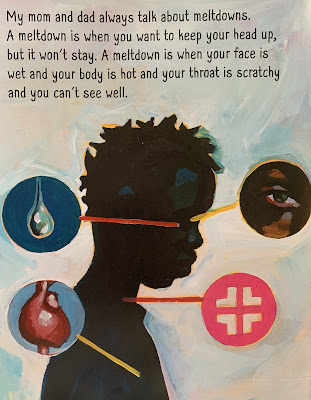Wise authors are looking back at classic children's literature and realizing their value. Below I have for you 3 recently published books with plots and themes very similar to Judith Viorst's 1972 classic Alexander and the Terrible, Horrible, No Good, Very Bad Day. Don't know Alexander? Here's my PBT post about this classic!
The healthy messages of these books are particularly important during this global pandemic! Acknowledging our feelings (confusion, anger, grief, sadness...) at home, school, and in religious settings will lead to better mental health for everyone. Here's a PBT post about that. It addresses the social-emotional needs of very young children via a theological statement that can be inserted into a secular book about feelings, BUT many books I feature there work for older children as well.
Also, I want you to know about 2 other books here if you only want to talk about sadness. Perhaps your congregation is grieving a loss or significant change. Click on titles to read posts about these very different PBT books:
Author: Aliya
King Neil
Illustrator: Charly Palmer
Summary: This beautiful book is quite similar to Alexander, but it has the wisdom of some modern psychology. D. is a little older, a tween or young teen. D. reminds himself that "Any day can be good if you try." And he does try, but the frustrations of home and school pile on him. When D. has a "meltdown," he is sent to the principal's office, where he is greeted by Miss King, who has been helping him. Her role is unclear, likely a school counselor or school psychologist. D.'s family is also helpful. They set reasonable limits, talk openly about his feelings, and encourage him to "Keep his head up." When he doesn't want to, D. knows he can at least try.
Original Publisher: Simon & Schuster, 2021
Age Appropriateness: 5 and up
Formats other than Book: Tablet
Picture Book: Benji, the Bad Day, and Me
Author: Sally
J. Pla
Illustrator: Ken Min
Summary: Here the most significant and welcome difference from Viorst's classic is that the main character is an older brother to a child on the autism spectrum. This difference offers opportunities to talk about the importance of empathy, prioritizing people's needs, and concepts of fairness & justice. Although the older brother's day has gone terribly, his mother is very focused on her younger child's significant needs. It is the younger brother who finally offers comfort to the main character. Then mom, who no doubt needs comfort too, joins in, and the story ends beautifully.
Hanna’s Comments:Original Publisher: Lee & Low, 2018
Age Appropriateness: 5 and up
Formats other than Book: None at present
Picture Book: Kevin the Unicorn: It’s Not All Rainbows
Author/Illustrator: Jessica von Innerebner
Summary: Alexander and Kevin's worlds are about as different as they can be! Kevin is expected to be perfect and everyday is expected to be sparkly - "filled with MAGICAL AWESOMENESS!" But Kevin, like Alexander, D. and Samuel, is having a bad day. Although he tries to be joyful, the constant barrage of positive messages in Kevin's world only confuse him. Eventually, he can no longer hide his feelings. His declaration invites others to be more honest about the bad day they are having. Kevin is not alone in his feelings. Such connections are crucial to humans and even unicorns, I suspect!
Given the color palate, I hope you won't assume this is a book for girls only. The main character is named Keven, after all. At present, there is another book about Kevin the Unicorn: Why Can’t We Be Bestie-Corns?
Original Publisher: Dial Books, 2019
Age Appropriateness: 4 and up
Formats other than Book: Tablet
Scripture Connections for these 3 books: Any scripture that involves Lamentation or Complaint to God connects to these books.
OR Bible stories about characters that are suffering, such as Job, can be particularly powerful. Try not to get into why bad things happen.
OR Get into the details of The Great Commandment. What does it means to love yourself AND love your neighbor when you are having a Terrible, Horrible, No Good, Very Bad Day?
PBT Applications: Read any of these books to dive into what lament looks like. Legitimize it as an important kind of prayer. Talk about how there is a whole book in the Bible named Lamentations and how many of the Psalms include complaints to God. More importantly, emphasize that God and those who love us most, want to know our real feelings. They can handle our negative feelings and can likely help us understand or move through them better. Sometimes just saying, "I am having a bad day!" is enough to help us feel better!










No comments:
Post a Comment